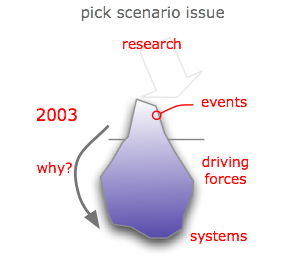Difference between revisions of "How to determine a driving force?"
| Line 9: | Line 9: | ||
Each driving force can be described using a number of attributes: | Each driving force can be described using a number of attributes: | ||
'''1. Name?''' Name the driving force, it helps to be specific (rather than “Demographics”, call it “The ageing of Europe” to indicate direction of the force) | |||
2. '''What:''' A short description of the driving force. | 2. '''What:''' A short description of the driving force. | ||
3. '''Enablers:''' Factors which strengthen this driving force. (these are actually other driving forces, and you can link to them in the wiki!) | 3. '''Enablers:''' Factors which strengthen this driving force. (these are actually other driving forces, and you can link to them in the wiki!) | ||
Revision as of 22:39, 21 November 2004
Changes in society, politics, technology, art, etc. are often only the symptoms of more fundamental transformations. For instance, high unemployment is the result of underlying forces in the labour market, which in turn are affected by such factors as the rate of productivity improvement.
Rather than working with an exact definition of a driving force what is important is to have a pragmatic approach. We start with an observable change and ask "Why?" repeatedly. Where to stop asking "why?" is also a pragmatic matter to be decided by common sense.

It would be naive to expect clear chains of causality. Instead what will emerge is a "web" of interrelated driving forces. This web will also not be static, but rather evolve. Over time new forces will be added, existing ones combined and/or replaced, etc.
Each driving force can be described using a number of attributes:
1. Name? Name the driving force, it helps to be specific (rather than “Demographics”, call it “The ageing of Europe” to indicate direction of the force) 2. What: A short description of the driving force. 3. Enablers: Factors which strengthen this driving force. (these are actually other driving forces, and you can link to them in the wiki!) 4. Inhibitors: Factors which weaken this driving force. (these are actually other driving forces, and you can link to them in the wiki!) 5. Paradigms: Changes in ways of thinking about the world due to the driving force. 6. Experts: Sources for additional information about this driving force. (if you have found people, put the links to them) 7. Timing: Dates for key milestones in the development of the driving force. 8. Web Resources: Useful resources on the web relating to this force.
A template to use for filling in the driving forces is to be found here Driving Forces Template
I would suggest that each person comes up with at least 2 DFs. (one for this Thursday and one for next Thursday) One of the easiest ways to do this, is to take a trade publication (i.e. a magazine/website that looks at your issue), look at the articles and start asking “why does this happen?, what creates this item”, and use that to go down the iceberg. Learn as much, and research as much about your issue as you can.
A older open driving force database exists on the DTN’s discussion forums for your reference. (http://www.dtn.net/community.html)